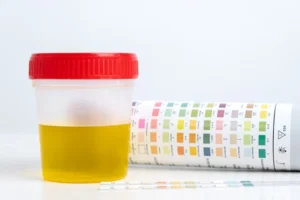0 votes, 0 avg 25
“Unlocking the Secrets of Urine: A Comprehensive Guide to Urine Examination”
Urine is a waste product its excrete from kidney .Urine remove waste product from our body it contains more that 98% water and other waste product like urea the Urine Examination is importance for metabolic disorder.

URINE EXAMINATION
Urine Examination it importance for diagnosis and assistance in the various disease routine examination of urine it’s divided into four part.
- SAMPLE COLLECTION
- PHYSICAL EXAMINATION
- CHEMICAL EXAMINATION
- MICROSCOPIC EXAMINATION
1. Sample Collection :-
The specimen should been properly collected in a clean container which should be properly labeled with the name of the patient, age, gender, identification with date and time collection.
Procedure:-
For routine examination a clean glass tube or capped jar is used morning first mid stream sample is best since it is most concentrate around 10-20 ml urine is required for routine examination .
2. Physical Examination Of Urine:-
Physical examination of urine is consisting following
- Volume
- Color
- Ph
- Specific gravity
- Odor and
- Appearance.
3. Chemical Examination Of Urine
Chemical examination of urine consists following examination.
- Bile Salt (Hay’s Sulphure Method)
- Glucoseuria (Benedict Method)
- Ketone Body (Rotheras, Gerhardt’s and Strip Method)
- Proteinuria (Heat and acetic acid, Sulpho Salicylic Acid,Hellers or Nitric acid, and Esbach albuminometer Method)
- Bence Jones Proteinuria (HCl Method)
- Urobilinogen (Ehrlich Method)
- Bile Pigment (Fouchets Method)
- Occult Blood (Orthotoluidine and Benzidine Method).
4. Microscopic examination of urine is consisting following steps.
- Sedimentation Preparation
- Slide Preparation
- Microscopic Examination.
Urine is unstained preparation and its microscopic examination is routinely done under reduce light using the light microscope low with partial closure of iris diaphragm. First examine it under low power field lens then under high power field and keep on changing the fine adjustment in order to visualize the sediments and report as number of cell, cast, crystal, per high power field.
Following constituents are frequently reported in the urine on microscopic examination.
- Cast
- Crystal
- Cells
- Miscellaneous Structure.
Also Read
- Examination of Specific gravity of urine
- Bile Salt (Hay’s Sulphure Method)
- Glucoseuria (Benedict Method)
- Ketone Body (Rotheras, Gerhardt’s and Strip Method)
- Proteinuria (Heat and acetic acid, Sulpho Salicylic Acid,Hellers or Nitric acid, and Esbach albuminometer Method)
- Bence Jones Proteinuria (HCl Method)
- Urobilinogen (Ehrlich Method)
- Bile Pigment (Fouchets Method)
- Occult Blood (Orthotoluidine and Benzidine Method).
- Sedimentation Preparation
- Slide Preparation
- Microscopic Examination.
Reference
- “Clinical Chemistry: Techniques, Principles, Correlations” by Michael L. Bishop and Edward P. Fody: This comprehensive text covers various aspects of clinical chemistry, including urinalysis. It’s widely used in medical and clinical laboratory education.
- “Henry’s Clinical Diagnosis and Management by Laboratory Methods” by Richard A. McPherson and Matthew R. Pincus: This is a well-regarded resource that provides insights into laboratory tests, including urinalysis, and their clinical applications.
- “Tietz Textbook of Clinical Chemistry and Molecular Diagnostics” by Nader Rifai, Andrea R. Horvath, and Carl T. Wittwer: This textbook offers a broad view of clinical chemistry, including urinalysis and molecular diagnostics, making it a valuable resource for students and professionals.
- “Urinalysis and Body Fluids” by Susan King Strasinger and Marjorie Schaub Di Lorenzo: This book is specifically focused on urinalysis and the examination of other body fluids. It is used in many medical laboratory technician programs.
- “Urinalysis in Clinical Laboratory Practice” by John A. Lott and W. Gregory Miller: This book provides a detailed look at the theory and practice of urinalysis, making it suitable for those studying or working in clinical laboratories.
- “Urine Analysis: A Color Atlas and Text” by David S. Goldfarb and Alan S. L. Yu: This text combines visual representations with explanatory text to aid in the understanding and interpretation of urine analysis.
- “Pathology Practical Book” by Harsh Mohan: Third Edition.
- Internet, Wikipedia